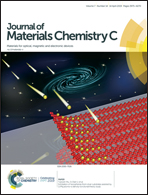The role of structural order and stiffness in the simultaneous enhancement of optical contrast and thermal stability in phase change materials†
Abstract
In the past several years, phase change materials (PCMs) have been widely applied in energy-saving non-volatile photonic devices, such as active perfect absorbers, nanopixel displays and all-photonic memories. To achieve high signal-to-noise ratio optical performance and high suitability for application in high temperature environments, PCMs should have both high optical contrast and thermal stability. However, the microscopic origins of these two properties have not been well explored. Integrating both properties into one PCM remains an open challenge. Here, we show that structural disorder and structural stiffness play key roles in improving the optical contrast and thermal stability of PCMs through a combination of experiments, theoretical calculations and spectral fittings. We obtain high optical contrast and thermal stability in one PCM by analyzing the differences in optical properties and electronic structures among the three most typical PCMs (Ge–Te, Sb–Te, and Ge–Sb–Te). Therefore, these results elucidate the dominant factors and physical mechanisms influencing the optical contrast and thermal stability of PCMs, which sheds new light on designing high-performance non-volatile optics based on PCMs.



 Please wait while we load your content...
Please wait while we load your content...